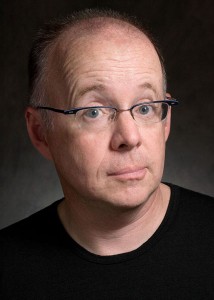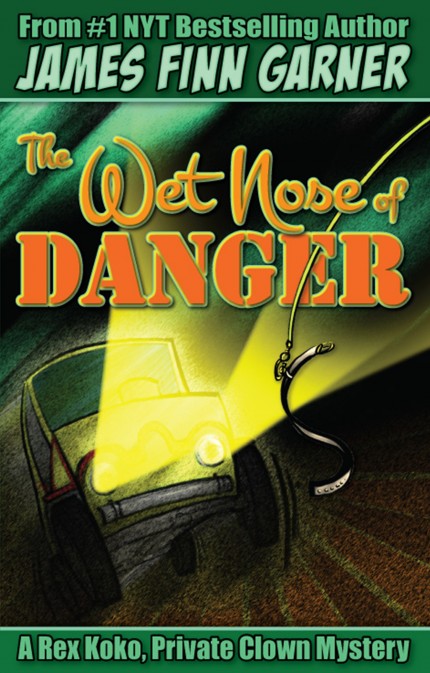January 16, 2016
Not All Clowning Around
An interview with author James Finn Garner - CWA's 2015 Book of the Year Award Winner for Non-Fiction, Non-Traditionally Published
By Christina Rodriguez
Writing a series is never an easy feat, especially when you dive into a world of crime with clown shoes. James Finn Garner manages to do it with flare and a ton of laughs, making his Rex Koko, Private Clown series a two-time Chicago Writers Association Book of the Year Award winner. Garner’s fictional Top Town is filled with a band of washed-up circus lifers with Rex Koko as the notorious, but strangely lovable main character, who is busy picking out all the wrong fights in town.
Garner, whose Politically Correct Bedtime Stories (1994) spent 60 weeks on the New York Times Best Seller List and eventually hit No. 1, self-published his so-called clown noir series, starting with Honk Honk, My Darling, which took home CWA’s Book of the Year Award in 2011 for Fiction, non-traditionally published. Then came Double Indignity and the latest, The Wet Nose of Danger, the 2015 winner for fiction in the non-traditionally published category.
The Wet Nose of Danger is actually a case of the chicken or the egg – or, in this case, the nose or the clown – as he wrote it before the first two books in the series but ended up releasing it third. Garner reads from his latest winning book at the Book Cellar in Chicago’s Lincoln Square neighborhood at 7 pm Saturday, Jan. 23 during CWA’s annual awards presentation. All are invited. It's free and open to the public. For Garner, it's not all clowning around. He has much to reveal about book publishing and clown lore, as he shares with us here.
In one sentence, what is The Wet Nose of Danger about? Tell me what interests you most about this book—or tell me other things, besides books, that might constellate around it.
Never get intimately involved with an elephant seal. There’s a price to pay.
How does/do your identity/ies feed into your writing?
When I was starting out in my 20s, I wanted to be taken seriously as a writer, yet this became a burden that made the actual writing more and more difficult. After a mini-breakdown, a friend recommended that I try some improv classes, to free up creative juices and meet some interesting people. That decision saved my life. It allowed me to wed the performer in me with the writer. My humorous side had almost been lost, beaten down by creative writing courses and juvenile self-regard! Now, I’m able to write, perform and teach, and keep things fresh by never getting too secure in any of them.
How does Chicago influence your writing or writing life?
Chicago is big enough to be stimulating, small enough that you can meet other writers very easily, and fluid enough that it’s rare to go to a party or event and meet nothing but writers (who are a stingy, jealous and self-absorbed bunch, if I might indulge in a little projection).
Tell us about the events that led to you writing The Wet Nose of Danger. What has been the most interesting?
This book is the third in a series, but it actually was the first one written. I had been fiddling around with some ideas, and began writing this mystery as a challenge to my agent. New York publishers had been giving me the brush off for a couple of years, so I decided to make this story completely over the top (and also created some characters on which to exact revenge). My agent liked it, surprisingly – even the refugee Nazis in dog suits – but told me it wasn’t a strong way to start a series. She told me to scale things back and center the story on Top Town, the ghetto of washed-up circus people, and grow my world more slowly. That book became Honk Honk, My Darling, which was a CWA Book of the Year in 2011. Her instincts were right.
Tales from the pit: Do you have any lessons or anecdotes to share about the publishing process or industry that you learned while publishing The Wet Nose of Danger?
Just the story about my agent. I won’t divulge which NY publishing people I murder in this book. But I will say it was the most satisfying aspect of writing it.
How long was the writing process for The Wet Nose of Danger? What kind of research did you have to do? What was the most challenging part?
Originally, the book took 2.5 years off and on. I shelved it to work on other Rex Koko books, then finished it in about 6 months. It probably went through nine drafts. The character of Rex Koko was created during my performing days, when my partners and I created parodies of old radio dramas onstage. When I decided to turn the idea into a book, I started digging more into the worlds of both crime fiction and circus lore. The circus subculture has a history that is abounding in details – slang, superstition, history, tradition, scandal, and more – and it provides endless ideas as I play with it. The most challenging part? Overcoming many people’s professed “fear of clowns”. Hey, I understand, but clowns are mythical agents of chaos – the flip side of the shaman, who tells you how to live to please the gods – and it provides terrific funny friction to make one into a crime solver. And besides: just as you wouldn’t judge all jazz music by attending a junior high jazz ensemble, don’t judge clowns by the amateurs who walk in Shriner’s parades.
Give a general overview of your work. What are your main concerns, ideas?
Just trying to shine a light on our basic human weaknesses for laughs.

James Finn Garner was born in Detroit and grew up in the company town of Dearborn, Michigan. After graduating from the University of Michigan (where he won a Hopwood Award for one of his short plays), he moved to Chicago and worked in a number of jobs, including house painter, baker, warehouse clerk, public relations whipping boy, and editor of real estate appraisal publications. Seeking a creative outlet, he began to take improvisational comedy classes and terrorized various Chicago nightclubs for many years. He currently lives in Chicago with his wife and two children. Garner has also nine written books and has published in Chicago Magazine, Playboy, The New York Times, The Wall Street Journal, TV Guide, The Chicago Tribune Magazine, Utne Reader, and other publications. You can grab more laughs with James Finn Garner and find out more about The Wet Nose of Danger at his website here.
Affiliates/Partners
Testimonials
Contact
Join CWA
Member Directory
My Account
Writers Conference
Presenters
Agents and Publishers
Pitch Sessions
Sponsors
Scholarships
Speaker Registration
Book of the Year
Spirit Award
First Chapter Contest
Resources
Home
Chicago Writers Association
info@chicagowrites.org
Make a Difference!


